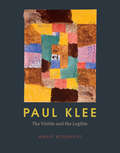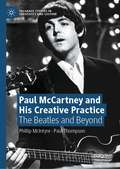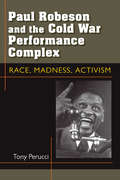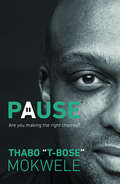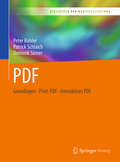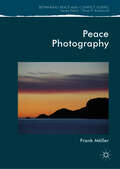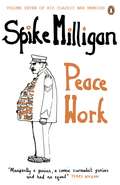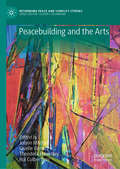- Table View
- List View
Paul Klee: The Visible and the Legible
by Annie BourneufThe fact that Paul Klee (1879–1940) consistently intertwined the visual and the verbal in his art has long fascinated commentators from Walter Benjamin to Michel Foucault. However, the questions it prompts have never been satisfactorily answered—until now. In Paul Klee, Annie Bourneuf offers the first full account of the interplay between the visible and the legible in Klee’s works from the 1910s and 1920s. Bourneuf argues that Klee joined these elements to invite a manner of viewing that would unfold in time, a process analogous to reading. From his elaborate titles to the small scale he favored to his metaphoric play with materials, Klee created forms that hover between the pictorial and the written. Through his unique approach, he subverted forms of modernist painting that were generally seen to threaten slow, contemplative viewing. Tracing the fraught relations among seeing, reading, and imagining in the early twentieth century, Bourneuf shows how Klee reconceptualized abstraction at a key moment in its development.
Paul Klee: The Visible and the Legible
by Annie BourneufThe fact that Paul Klee (1879–1940) consistently intertwined the visual and the verbal in his art has long fascinated commentators from Walter Benjamin to Michel Foucault. However, the questions it prompts have never been satisfactorily answered—until now. In Paul Klee, Annie Bourneuf offers the first full account of the interplay between the visible and the legible in Klee’s works from the 1910s and 1920s. Bourneuf argues that Klee joined these elements to invite a manner of viewing that would unfold in time, a process analogous to reading. From his elaborate titles to the small scale he favored to his metaphoric play with materials, Klee created forms that hover between the pictorial and the written. Through his unique approach, he subverted forms of modernist painting that were generally seen to threaten slow, contemplative viewing. Tracing the fraught relations among seeing, reading, and imagining in the early twentieth century, Bourneuf shows how Klee reconceptualized abstraction at a key moment in its development.
Paul Klee: The Visible and the Legible
by Annie BourneufThe fact that Paul Klee (1879–1940) consistently intertwined the visual and the verbal in his art has long fascinated commentators from Walter Benjamin to Michel Foucault. However, the questions it prompts have never been satisfactorily answered—until now. In Paul Klee, Annie Bourneuf offers the first full account of the interplay between the visible and the legible in Klee’s works from the 1910s and 1920s. Bourneuf argues that Klee joined these elements to invite a manner of viewing that would unfold in time, a process analogous to reading. From his elaborate titles to the small scale he favored to his metaphoric play with materials, Klee created forms that hover between the pictorial and the written. Through his unique approach, he subverted forms of modernist painting that were generally seen to threaten slow, contemplative viewing. Tracing the fraught relations among seeing, reading, and imagining in the early twentieth century, Bourneuf shows how Klee reconceptualized abstraction at a key moment in its development.
Paul McCartney and His Creative Practice: The Beatles and Beyond (Palgrave Studies in Creativity and Culture)
by Phillip McIntyre Paul ThompsonThis book provides fresh insight into the creative practice developed by Paul McCartney over his extended career as a songwriter, record producer and performing musician. It frames its examination of McCartney’s work through the lens of the systems model of creativity developed by Mihaly Csikszentmihalyi and combines this with the research work of Pierre Bourdieu. This systems approach is built around the basic structures of idiosyncratic agents, like McCartney himself, and the choices he has made as a creative individual. It also locates his work within social fields and cultural domains, all crucial aspects of the creative system that McCartney continues to be immersed in. Using this tripartite system, the book includes analysis of McCartney’s creative collaborations with musicians, producers, artists and filmmakers and provides a critical analysis of the Romantic myth which forms a central tenet of popular music. This engaging work will have interdisciplinary appeal to students and scholars of the psychology of creativity, popular music, sociology and cultural studies.
Paul Robeson and the Cold War Performance Complex: Race, Madness, Activism (Theater: Theory/Text/Performance)
by Tony PerucciActor and singer Paul Robeson's performances in Othello, Show Boat, and The Emperor Jones made him famous, but his midcentury appearances in support of causes ranging from labor and civil rights to antilynching and American warmongering made him notorious. When Robeson announced at the 1949 Paris Peace Conference that it was "unthinkable" for blacks to go to war against the Soviet Union, the mainstream American press declared him insane. Notions of Communism, blackness, and insanity were interchangeably deployed during the Cold War to discount activism such as Robeson's, just a part of an array of social and cultural practices that author Tony Perucci calls the Cold War performance complex. Focusing on two key Robeson performances---the concerts in Peekskill, New York, in 1949 and his appearance before the House Committee on Un-American Activities in 1956---Perucci demonstrates how these performances and the government's response to them are central to understanding the history of Cold War culture in the United States. His book provides a transformative new perspective on how the struggle over the politics of performance in the 1950s was also a domestic struggle over freedom and equality. The book closely examines both of these performance events as well as artifacts from Cold War culture---including congressional documents, FBI files, foreign policy papers, the popular literature on mental illness, and government propaganda films---to study the operation of power and activism in American Cold War culture.
Paula Rego's Map of Memory: National and Sexual Politics
by Maria Manuel LisboaThis title was first published in 2003. The artist Paula Rego was born in Portugal but has lived in Britain since 1951. In this well-illustrated book, Maria Manuel Lisboa explores the background behind Rego's decision to leave the land of her birth and, in doing so, provides fascinating insights into Rego's persistent portrayal of uneasy and predatory relations between men and women. Looking back over the national, religious and sexual politics of Portugal during Rego's childhood under the shadow of the Salazar dictatorship and subsequently, Lisboa locates the origins of the artist's preoccupation with power and powerlessness, violence and abuse within the political and ideological status quo of Portugal, past and present. The author's clear and thoughtful analysis offers an ambitious contribution to the study of patriarchy, Catholicism and Fascism and their expression in the work of this artist.
Paula Rego's Map of Memory: National and Sexual Politics
by Maria Manuel LisboaThis title was first published in 2003. The artist Paula Rego was born in Portugal but has lived in Britain since 1951. In this well-illustrated book, Maria Manuel Lisboa explores the background behind Rego's decision to leave the land of her birth and, in doing so, provides fascinating insights into Rego's persistent portrayal of uneasy and predatory relations between men and women. Looking back over the national, religious and sexual politics of Portugal during Rego's childhood under the shadow of the Salazar dictatorship and subsequently, Lisboa locates the origins of the artist's preoccupation with power and powerlessness, violence and abuse within the political and ideological status quo of Portugal, past and present. The author's clear and thoughtful analysis offers an ambitious contribution to the study of patriarchy, Catholicism and Fascism and their expression in the work of this artist.
Paula Vogel (Michigan Modern Dramatists)
by Joanna MansbridgePaula Vogel’s plays, including the Pulitzer–prizewinning How I Learned to Drive, initiate a conversation with contemporary culture, staging vexed issues like domestic violence, pornography, and AIDS. She does not write "about" these concerns, but instead examines how they have become framed as “issues”–as sensationalized topics–focusing on the histories and discourses that have defined them and the bodies that bear their meanings. Mobilizing campy humor, keen insight, and nonlinear structure, her plays defamiliarize the identities and issues that have been fixed as "just the way things are." Vogel crafts collage-like playworlds that are comprised of fragments of history and culture, and that are simultaneously inclusive and alienating, familiar and strange, funny and disturbing. At the center of these playworlds are female characters negotiating with the images and discourses that circumscribe their lives and bodies. In this, the first book-length study of Vogel and her work, Joanna Mansbridge explores how Vogel’s plays speak back to the canon, responding to and rewriting works by William Shakespeare, Edward Albee, Sam Shepard, and David Mamet, rearranging their plots, revising their conflicts, and recasting their dramatis personae. The book examines the theories shaping the playwright and her plays, the production and reception of her work, and the aesthetic structure of each play, grounding the work in cultural materialist, feminist and queer theory, and theater and performance studies scholarship.
Pause: Are you making the right choices?
by Thabo T-Bose MokweleWhen we learn from each other, that’s when we learn more about ourselves.With a radio career spanning more than three decades, Thabo T-Bose Mokwele brings topics to the airwaves that challenge and invoke human introspection and dialogue with his audience. And through this he has learned a lot about life and its nuances. Pause is a collection of Thabo’s observations, reflections and learnings about what life is about. Simply put, this is the book he wishes he had read before starting his adult life journey.Pause is a compilation of Thabo's pearls of wisdom and lessons about life, God, money, relationships, parenting and, most importantly, self-mastery. His knowledge has been acquired by reading other philosophers' views on life and love, from interviewing entrepreneurs and entertainers about self-sufficiency, and preachers and teachers about self-mastery. This, you may say, is his ‘bible’, to drive his life, and a lens through which he views his existence.Thabo shares what he knows, what he practises and what still challenges him. It’s a book that everyone, from teens to adults, should read for a glimpse, and as a guide, to living a life that is meaningful.We learn from our mistakes, but some mistakes are costly and should never be repeated. And if reading a short chapter on a particular topic can help mould a young person’s life, or assist an adult to self-correct, then Pause is a must-read.Thabo says: We all need to learn, unlearn and relearn many things in order to fully realise who we are meant to be.
Pavement Materials and Associated Geotechnical Aspects of Civil Infrastructures: Proceedings of the 5th GeoChina International Conference 2018 – Civil Infrastructures Confronting Severe Weathers and Climate Changes: From Failure to Sustainability, held on July 23 to 25, 2018 in HangZhou, China (Sustainable Civil Infrastructures)
by WJvdM Steyn Irina Holleran BooHyun NamThis book contains latest research studies regarding issues related to civil infrastructure such as pavement layers and material properties. It contains research data and conclusions that should lead to more resilient infrastructure design, maintenance and management. Civil engineering researchers and practitioners will gain valuable information from this material. Papers were selected from the 5th GeoChina International Conference on Civil Infrastructures Confronting Severe Weathers and Climate Changes: From Failure to Sustainability, held on July 23-25, 2018 in HangZhou, China.
Pavilions, Pop Ups and Parasols: The Impact of Real and Virtual Meeting on Physical Space (Architectural Design)
by Leon Van Schaik Fleur WatsonAround the world, a new architectural form is emerging. In public places a progressive architecture is being commissioned to promote open-ended, undetermined, lightly programmed or un-programmed interactions between people. This new phenomenon of architectural form – Pavilions, Pop-Ups and Parasols – is presaged by rapidly changing social relationships flowing from social media such as Facebook, Twitter and Instagram. The nexus between real and virtual meeting is effectively being reinvented by innovative and creative architectural practices. People meet in new and responsive ways, architects meet their clients in new forums, knowledge is ‘met’ and achieved in new and interactive frameworks. It contrasts bluntly with the commercially structured interactions of shopping malls and the increasingly deliberate interactions available in cultural institutions. These experiences imbue a new type of client; casually engaged, flocking, hacking, crowd funding and self-helping. Contributors include: Rob Bevan, Pia Ednie-Brown, Roan Ching-Yueh, Dan Hill, Martyn Hook, Minsuk Cho, Andrea Kahn, Felicity Scott, Akira Suzuki Contributing architects include: Alisa Andrasek/Biothing, Peter Cook/CRAB studio, CJ Lim/Studio 8, Tom Holbrook/5th Studio, Matthias Hollwich/HWKN, Mamou-Mani Architects, Benedetta Tagliabue/EMBT
Pay for Your Pleasures: Mike Kelley, Paul McCarthy, Raymond Pettibon
by Cary LevineMike Kelley, Paul McCarthy, and Raymond Pettibon—these Southern California artists formed a “bad boy” trifecta. Early purveyors of abject art, the trio produced work ranging from sculptures of feces to copulating stuffed animals, and gained notoriety from being perverse. Showing how their work rethinks transgressive art practices in the wake of the 1960s, Pay for Your Pleasures argues that their collaborations as well as their individual enterprises make them among the most compelling artists in the Los Angeles area in recent years. Cary Levine focuses on Kelley’s, McCarthy’s, and Pettibon’s work from the 1970s through the 1990s, plotting the circuitous routes they took in their artistic development. Drawing on extensive interviews with each artist, he identifies the diverse forces that had a crucial bearing on their development—such as McCarthy’s experiences at the University of Utah, Kelley’s interest in the Detroit-based White Panther movement, Pettibon’s study of economics, and how all three participated in burgeoning subcultural music scenes. Levine discovers a common political strategy underlying their art that critiques both nostalgia for the 1960s counterculture and Reagan-era conservatism. He shows how this strategy led each artist to create strange and unseemly images that test the limits of not only art but also gender roles, sex, acceptable behavior, poor taste, and even the gag reflex that separates pleasure from disgust. As a result, their work places viewers in uncomfortable situations that challenge them to reassess their own values. The first substantial analysis of Kelley, McCarthy, and Pettibon, Pay for Your Pleasures shines new light on three artists whose work continues to resonate in the world of art and politics.
Pay for Your Pleasures: Mike Kelley, Paul McCarthy, Raymond Pettibon
by Cary LevineMike Kelley, Paul McCarthy, and Raymond Pettibon—these Southern California artists formed a “bad boy” trifecta. Early purveyors of abject art, the trio produced work ranging from sculptures of feces to copulating stuffed animals, and gained notoriety from being perverse. Showing how their work rethinks transgressive art practices in the wake of the 1960s, Pay for Your Pleasures argues that their collaborations as well as their individual enterprises make them among the most compelling artists in the Los Angeles area in recent years. Cary Levine focuses on Kelley’s, McCarthy’s, and Pettibon’s work from the 1970s through the 1990s, plotting the circuitous routes they took in their artistic development. Drawing on extensive interviews with each artist, he identifies the diverse forces that had a crucial bearing on their development—such as McCarthy’s experiences at the University of Utah, Kelley’s interest in the Detroit-based White Panther movement, Pettibon’s study of economics, and how all three participated in burgeoning subcultural music scenes. Levine discovers a common political strategy underlying their art that critiques both nostalgia for the 1960s counterculture and Reagan-era conservatism. He shows how this strategy led each artist to create strange and unseemly images that test the limits of not only art but also gender roles, sex, acceptable behavior, poor taste, and even the gag reflex that separates pleasure from disgust. As a result, their work places viewers in uncomfortable situations that challenge them to reassess their own values. The first substantial analysis of Kelley, McCarthy, and Pettibon, Pay for Your Pleasures shines new light on three artists whose work continues to resonate in the world of art and politics.
PC Wars: Politics and Theory in the Academy
by Jeffrey WilliamsFirst Published in 1995. Routledge is an imprint of Taylor & Francis, an informa company.
PC Wars: Politics and Theory in the Academy
by Jeffrey WilliamsFirst Published in 1995. Routledge is an imprint of Taylor & Francis, an informa company.
PCM-Based Building Envelope Systems: Innovative Energy Solutions for Passive Design (Green Energy and Technology)
by Benjamin DurakovićPCM Enhanced Building Envelopes presents the latest research in the field of thermal energy storage technologies that can be applied to solar heating and cooling with the aim of shifting and reducing building energy demand. It discusses both practical and technical issues, as well as the advantages of using common phase change materials (PCMs) in buildings as a more efficient, novel solution for passive solar heating/cooling strategies. The book includes qualitative and quantitative descriptions of the science, technology and practices of PCM-based building envelopes, and reflects recent trends by placing emphasis on energy storage solutions within building walls, floors, ceilings, façades, windows, and shading devices. With the aim of assessing buildings’ energy performance, the book provides advanced modeling and simulation tools as a theoretical basis for the analysis of PCM-based building envelopes in terms of heat storage and transfer. This book will be of interest to all those dealing with building energy analysis such as researchers, academics, students and professionals in the fields of mechanical and civil engineering and architectural design
PCM-Enhanced Building Components: An Application of Phase Change Materials in Building Envelopes and Internal Structures (Engineering Materials and Processes)
by Jan KośnyPresenting an overview of the use of Phase Change Materials (PCMs) within buildings, this book discusses the performance of PCM-enhanced building envelopes. It reviews the most common PCMs suitable for building applications, and discusses PCM encapsulation and packaging methods. In addition to this, it examines a range of PCM-enhanced building products in the process of development as well as examples of whole-building-scale field demonstrations. Further chapters discuss experimental and theoretical analyses (including available software) to determine dynamic thermal and energy performance characteristics of building enclosure components containing PCMs, and present different laboratory and field testing methods. Finally, a wide range of PCM building products are presented which are commercially available worldwide. This book is intended for students and researchers of mechanical, architectural and civil engineering and postgraduate students of energy analysis, dynamic design of building structures, and dynamic testing procedures. It also provides a useful resource for professionals involved in architectural and mechanical-civil engineering design, thermal testing and PCM manufacturing.
PDE and Level Sets: Algorithmic Approaches to Static and Motion Imagery (Topics in Biomedical Engineering)
by Swamy LaxminarayanPDE & Level Sets: Algorithmic Approaches to Static & Motion Imagery is specially dedicated to the segmentation of complex shapes from the field of imaging sciences using level sets and PDEs. It covers the fundamentals of level sets, different kinds of concepts of both geodesic curvature flows and planar flows, as well as the power of incorporation of regional-statistics in level set framework. In covering this material, this book presents segmentation of object-in-motion imagery based on level sets in eigen analysis framework, while also presenting classical problems of boundary completion in cognitive images, like the pop-up of subjective contours in the famous triangle of Kanizsa using surface evolution framework, or the mean curvature evolution of a graph with respect to the Riemannian metric induced by the image. All results are presented for modal completion of cognitive objects with missing boundaries.
PDF: Grundlagen – Print-PDF – Interaktives PDF (Bibliothek der Mediengestaltung)
by Peter Bühler Patrick Schlaich Dominik SinnerDieser Band der „Bibliothek der Mediengestaltung“ behandelt die Erstellung und Bearbeitung professioneller PDF-Dateien im Print-Workflow der Druckvorstufe und als interaktives digitales Medium.Für diese Bibliothek wurden die Themen des Kompendiums der Mediengestaltung neu strukturiert, vollständig überarbeitet und in ein handliches Format gebracht. Leitlinien waren hierbei die Anpassung an die Entwicklungen in der Werbe- und Medienbranche sowie die Berücksichtigung der aktuellen Rahmenpläne und Studienordnungen sowie Prüfungsanforderungen der Ausbildungs- und Studiengänge.Die Bände der „Bibliothek der Mediengestaltung“ enthalten zahlreiche praxisorientierte Aufgaben mit Musterlösungen und eignen sich als Lehr- und Arbeitsbücher an Schulen sowie Hochschulen und zum Selbststudium.
Peace Photography (Rethinking Peace and Conflict Studies)
by Frank MöllerThis study thinks with photography about peace. It asks how photography can represent peace, and how such representation can contribute to peace. The book offers an original critique of the almost exclusive focus on violence in recent work on visual culture and presents a completely new research agenda within the overall framework of visual peace research. Critically engaging with both photojournalism and art photography in light of peace theories, it looks for visual representations or anticipations of peace – peace or peace as a potentiality – in the work of selected photographers including Robert Capa and Richard Mosse, thus reinterpreting photography from the Spanish Civil War to current anti-migration politics in Europe. The book argues that peace photography is episodic, culturally specific, process-oriented and considerate of both the past and the future.
Peace, War and Computers
by Chris Hables GrayComputers are at the heart of war as we know it and this visionary overview of cyber war in the twenty-first century studies how electronics have changed the way we fight. Using informatics and chaos theory, this is a disarming, yet enthralling read.
Peace, War and Computers
by Chris Hables GrayComputers are at the heart of war as we know it and this visionary overview of cyber war in the twenty-first century studies how electronics have changed the way we fight. Using informatics and chaos theory, this is a disarming, yet enthralling read.
Peace Work (Spike Milligan War Memoirs #7)
by Spike MilliganSpike Milligan's legendary war memoirs are a hilarious and subversive first-hand account of the Second World War, as well as a fascinating portrait of the formative years of this towering comic genius, most famous as writer and star of The Goon Show. They have sold over 4.5 million copies since they first appeared.'The most irreverent, hilarious book about the war that I have ever read' Sunday Express'Brilliant verbal pyrotechnics, throwaway lines and marvelous anecdotes' Daily Mail'Desperately funny, vivid, vulgar' Sunday Times'I had not informed my parents of my return, I wanted it to be a lovely surprise; it was, for me, they were away ...' The seventh and last volume of Spike Milligan's memoirs sees our hero returning from war and Italy ... but to what? Aside from shooting large, inaccurate guns at Germans, all he has done for five long years is blow a trumpet, tell rude jokes and write and perform sketches for the entertainment of bored and murderous soldiers - who on earth is going to pay a civilian to do more of that? From the giddy heights of Hackney Empire to a Zurich Freak Show and beyond, Spike makes his way through the backwaters of showbiz, first as band musician then as one-man wild-act and eventually in the company of a group of like-minded comedians called Harry Secombe, Michael Bentine and Peter Sellers. They decide to call themselves The Goons...'That absolutely glorious way of looking at things differently. A great man' Stephen Fry'Milligan is the Great God to all of us' John Cleese'The Godfather of Alternative Comedy' Eddie Izzard'Manifestly a genius, a comic surrealist genius and had no equal' Terry Wogan'A totally original comedy writer' Michael Palin'Close in stature to Lewis Carroll and Edward Lear in his command of the profound art of nonsense' GuardianSpike Milligan was one of the greatest and most influential comedians of the twentieth century. Born in India in 1918, he served in the Royal Artillery during WWII in North Africa and Italy. At the end of the war, he forged a career as a jazz musician, sketch-show writer and performer, before joining forces with Peter Sellers and Harry Secombe to form the legendary Goon Show. Until his death in 2002, he had success as on stage and screen and as the author of over eighty books of fiction, memoir, poetry, plays, cartoons and children's stories.
Peacebuilding and the Arts (Rethinking Peace and Conflict Studies)
by Jolyon Mitchell Giselle Vincett Theodora Hawksley Hal Culbertson"Ending violent conflict requires societies to take leaps of political imagination. Artistic communities are often uniquely placed to help promote new thinking by enabling people to see things differently. In place of conflict’s binary divisions, artists are often charged with exploring the ambiguities and possibilities of the excluded middle. Yet, their role in peacebuilding remains little explored. This excellent and agenda-setting volume provides a ground-breaking look at a range of artistic practices, and the ways in which they have attempted to support peacebuilding – a must-read for all practitioners and policy-makers, and indeed other peacemakers looking for inspiration."Professor Christine Bell, FBA, Professor of Constitutional Law, Assistant Principal (Global Justice), and co-director of the Global Justice Academy, The University of Edinburgh, UK"Peacebuilding and the Arts offers an impressive and impressively comprehensive engagement with the role that visual art, music, literature, film and theatre play in building peaceful and just societies. Without idealizing the role of the arts, the authors explore their potential and limits in a wide range of cases, from Korea, Cambodia, Colombia and Northern Ireland to Uganda, Rwanda, South Africa and Israel-Palestine."Roland Bleiker, Professor of International Relations, University of Queensland, Australia, and author of Aesthetics and World Politics and Visual Global Politics"Peacebuilding and the Arts is the first publication to focus critically and comprehensively on the relations between the creative arts and peacebuilding, expanding the conventional boundaries of peacebuilding and conflict transformation to include the artist, actor, poet, novelist, dramatist, musician, dancer and film director. The sections on the visual arts, music, literature, film and theatre, include case studies from very different cultures, contexts and settings but a central theme is that the creative arts can play a unique and crucial role in the building of peaceful and just societies, with the power to transform relationships, heal wounds, and nurture compassion and empathy. Peacebuilding and the Arts is a vital and unique resource which will stimulate critical discussion and further research, but it will also help to refine and reframe our understanding of peacebuilding. While it will undoubtedly become mandatory reading for students of peacebuilding and the arts, its original approach and dynamic exploratory style should attract a much wider interdisciplinary audience."Professor Anna King, Professor of Religious Studies and Social Anthropology and Director of Research, Centre of Religion, Reconciliation and Peace (WCRRP), University of Winchester, UKThis volume explores the relationship between peacebuilding and the arts. Through a series of original essays, authors consider some of the ways that different art forms (including film, theatre, music, literature, dance, and other forms of visual art) can contribute to the processes and practices of building peace. This book breaks new ground, by setting out fresh ways of analysing the relationship between peacebuilding and the arts. Divided into five sections on the Visual Arts, Music, Literature, Film and Theatre/Dance, over 20 authors offer conceptual overviews of each art form as well as new case studies from around the globe and critical reflections on how the arts can contribute to peacebuilding. As interest in the topic increases, no other book approaches this complex relationship in the way that Peacebuilding and the Arts does. By bringing together the insights of scholars and practitioners working at the intersection of the arts and peacebuilding, this book develops a series of unique, critical perspectives on the interaction of diverse art forms with a range of peacebuilding endeavours.
Peacock Revolution: American Masculine Identity and Dress in the Sixties and Seventies (Dress and Fashion Research)
by Daniel Delis HillThe Peacock Revolution in menswear of the 1960s came as a profound shock to much of America. Men's long hair and vividly colored, sexualized clothes challenged long established traditions of masculine identity. Peacock Revolution is an in-depth study of how radical changes in men's clothing reflected, and contributed to, the changing ideas of American manhood initiated by a 'youthquake' of rebellious baby boomers coming of age in an era of social revolutions. Featuring a detailed examination of the diverse socio-cultural and socio-political movements of the era, the book examines how those dissents and advocacies influenced the youthquake generation's choices in dress and ideas of masculinity. Daniel Delis Hill provides a thorough chronicle of the peacock fashions of the time, beginning with the mod looks of the British Invasion in the early 1960s, through the counterculture street styles and the mass-market trends they inspired, and concluding with the dress-for-success menswear revivals of the 1970s Me-Decade.
